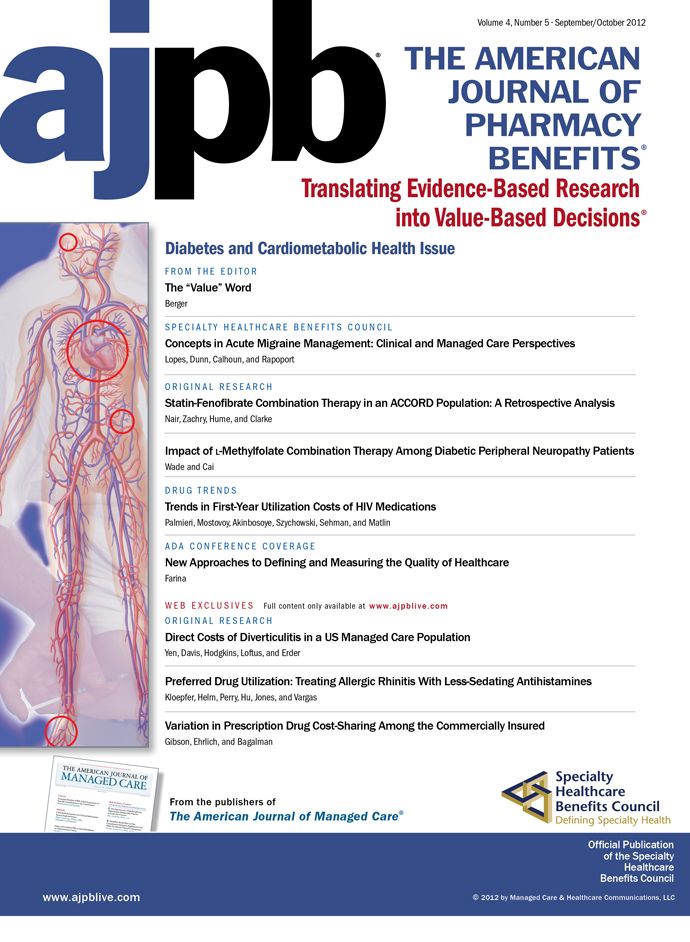Publication
Article
AJPB® Translating Evidence-Based Research Into Value-Based Decisions®
Articulating Patient Involvement in FDA Regulatory Reviews
Author(s):
Use of a simple model developed by the patient advocacy community could facilitate valuable dialogue between the FDA and people with chronic conditions.
The US Food and Drug Administration (FDA) has acknowledged that “The medical product review process could benefi t from a more scientific, systematic, and expansive approach to obtaining input from patients who are experiencing a particular disease condition.”1 People with chronic diseases and disabilities agree. At times, patients feel that the regulatory review process does not refl ect their thinking about the benefi ts and risks associated with potential medicines that might treat their conditions.
With more than 75% of all healthcare costs due to chronic conditions, it is imperative that the personal circumstances and preferences of people with chronic diseases and disabilities be incorporated at various points during the regulatory review process.2,3
The patient advocacy community has developed a simple model that the FDA could use to articulate the primary points for engaging with patients, family caregivers, and consumers at each stage of the regulatory review process (drug development, drug approval, and post market); why such input is needed; and from which audiences the input should come—ie, the individual patients, family caregivers, consumers, and/or the organizations that represent them (
Figure
). The contextual input provided by these stakeholders will help the agency more closely align the evaluation of benefi ts and risks of new drugs with the end user, resulting in new treatments that address the outcomes most important to patients and consumers.
While patients and consumers share many concerns, their perspectives on the benefi ts and risks of new drugs often differ significantly. People with chronic diseases and disabilities rely continuously on the healthcare system to enable longer, healthier, and more robust lives. A consumer, on the other hand, is a generally healthy individual who will move in and out of the healthcare system as his or her needs change over time. As such, a consumer’s perception benefit-risk, and in particular his or her tolerance for risk and uncertainty, may differ dramatically from that of a patient.
The missions of the organizations that represent patients and consumers differ as well. A consumer advocacy organization seeks to ensure the rights and safety of consumers. In the context of healthcare, a main aim of a consumer advocacy organization may be to ensure that a consumer’s interaction with the healthcare system is safe. While patient advocacy organizations share this aim, a patient advocacy organization seeks to ensure that goals to improve safety are balanced with the need to improve treatment options and find cures.
Patient advocacy organizations and their trained volunteers take a holistic view and represent the full spectrum of perspectives that people with a particular condition may have. These organizations are an asset, not only to help the FDA reach out to patients but also to provide the knowledge and depth of experience that may be diffi cult for individual patients to convey.
As the FDA systematically engages with patients, family caregivers, and consumers in the regulatory review process, the agency should use a range of methods in soliciting input. In the context of specifi c studies, face-to- face meetings will be particularly helpful when seeking targeted input on a highly technical topic, whereas web-based or survey-based methods could be more appropriate when the FDA is seeking input from as broad an audience as possible. When evaluating different modalities for soliciting input, the agency must also consider how these methods may be enhanced to ensure that patient representation is broad and diverse.
Conversely, the FDA should also consider how certain modalities may inadvertently hinder participation of certain populations. In its 2001 report, Crossing the Quality Chasm, the Institute of Medicine pointed out that equity is achieved by providing care that does not vary in quality because of personal characteristics such as gender, race or ethnicity, geographic location, or socioeconomic status.4 The FDA should seek to ensure that its engagement process facilitates the inclusion of perspectives of patients that may have traditionally been under-represented and results in patient representation that reflects the diversity of our nation.
Given the different perspectives that patients, family caregivers, consumers, and the organizations that serve these segments of society lend to the regulatory review process, it follows that the point at which their input would be most valuable and warranted could differ as well.
The FDA has provided examples of the topics on which the agency believes the patient community could add valuable insight.1 The agency has included on the list the impact of the disease on a patient’s daily life, the effectiveness of therapies with the progression of a disease, and therapeutic variations by patient subpopulations. What is unclear is at which points throughout the regulatory review process input from the patient community would be sought. It is obviously insufficient to incorporate patient knowledge and understanding merely at 1 point in time, such as at the front end or the back end of a regulatory review.
As presented in the Figure, both patients and their organizations could provide valuable input during the development stage as understanding of the benefi ts and risks of a given drug evolve. Individual patient input is likely more important during the approval of a specific product, while the views of patient organizations may be more relevant as new information emerges after the drug is available on the market.
By using this model developed by the patient advocacy community outlining who, why, and when various stakeholders are engaged, the FDA can facilitate an expansive dialogue with people with chronic conditions about the benefi ts and risks of new treatments and ensure that regulatory judgments are informed by the dynamic views of people who ultimately will take the drugs.







